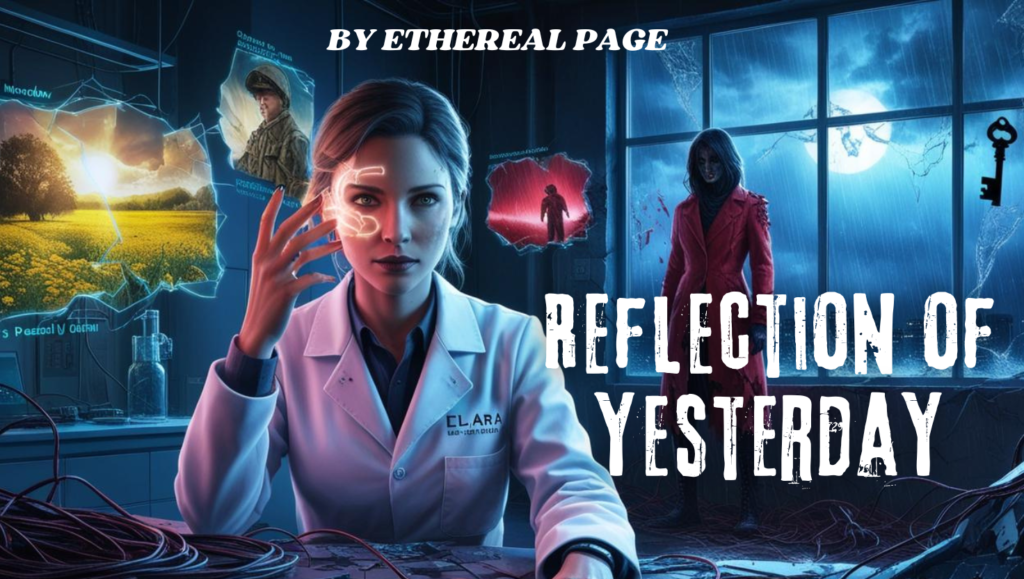“The past isn’t just remembered—it can rewrite you.”
In the year 2047, Dr. Elara Voss, a reclusive neuroscientist, discovered a way to extract memories from the human brain and project them as holograms. Her invention, the Chronoptic Lens, was meant to help Alzheimer’s patients relive forgotten moments—including her father, whose mind was fading fast. But when she stumbled upon a memory “that wasn’t hers”, the line between past and present began to unravel.
Elara’s breakthrough came on a rain-soaked night in her underground lab. Her father, seated in a chair wired to the Lens, suddenly recalled a vivid memory: a sunlit meadow, a woman in a red coat, and a whispered argument about a “gateway.” But her father had never owned a red coat, and the meadow resembled a valley 200 miles away—a place he’d never visited.
“Who is she?” Elara asked, freezing the hologram. Her father’s eyes widened. “You shouldn’t see this.”
Before she could probe further, he suffered a seizure. The memory dissolved, leaving only a glitching timestamp: “10.23.1985”. A date ‘decades’ before the Lens was invented.
Elara’s obsession deepened. She began covertly testing the device on herself, chasing the mystery. Each time she activated the Lens, she slipped into strangers’ memories—a soldier’s final moments in a warzone, a thief’s heist, a kiss between lovers in a Paris café. But the 1985 memory always reappeared, clearer each time. The woman in red now held a key engraved with a symbol: “Ψ”, the Greek letter for “psi”.
Her corporate backers at NexaCorp grew suspicious. “Focus on medical applications,” warned Dr. Rylan Cole, her icy-eyed supervisor. But Elara ignored him, hacking into NexaCorp’s servers to find files on “Project Mnemosyne”—a Cold War-era CIA program experimenting with psychic espionage. The woman in red was Agent Mara Voss. ‘Her’ mother.
Shocked, Elara confronted her ailing father. He confessed: Mara had been part of a team that discovered a psychic “echo network,” allowing access to anyone’s memories across time. But the experiment backfired. Participants began losing their identities, overwritten by foreign memories. Mara had hidden the research, and the Ψ key, before vanishing in 1985.
“She didn’t abandon us,” her father whispered. “The network took her.”
That night, NexaCorp stormed Elara’s lab. Dr. Cole revealed the truth: They’d weaponized her work to extract secrets from dead agents’ memories. The 1985 timestamp was a “rift” in the echo network—a backdoor to infinite knowledge. But Mara had sealed it with the Ψ key, now etched into Elara’s DNA.
“You’re the only one who can reopen it,” Cole said, pressing a gun to her father’s head.
In a desperate gamble, Elara activated the Lens, diving into the 1985 memory. This time, she controlled it. She confronted Mara’s echo, who warned, “The network consumes you. Forget the key.” But Elara refused. Using her mother’s psyche as an anchor, she rewrote the memory, trapping Cole’s team in a recursive loop of their darkest regrets.
The lab exploded in a burst of neural feedback. Elara awoke days later, her father beside her in a hospital. NexaCorp was in ruins, its leaders institutionalized, babbling about “faces in the static.”
But victory came at a cost. The Lens had scarred Elara’s mind. Her childhood memories—graduations, birthdays, her mother’s laugh—were now strangers’ recollections. Yet in their place flickered something new: the faintest thread of Mara’s voice, guiding her to let go.
Epilogue:
Elara dismantled the Lens, opting to care for her father in the quiet present. Some mornings, she’d find him sketching a meadow or humming a forgotten lullaby. She no longer knew if the memories were his, hers, or someone else’s. But in the way he squeezed her hand, she felt a truth deeper than any hologram:
Some echoes were meant to fade.
The End.
✨ Twist: The final scene implies Elara’s father has begun inheriting her lost memories, suggesting the echo network still lingers… and the story isn’t over.




